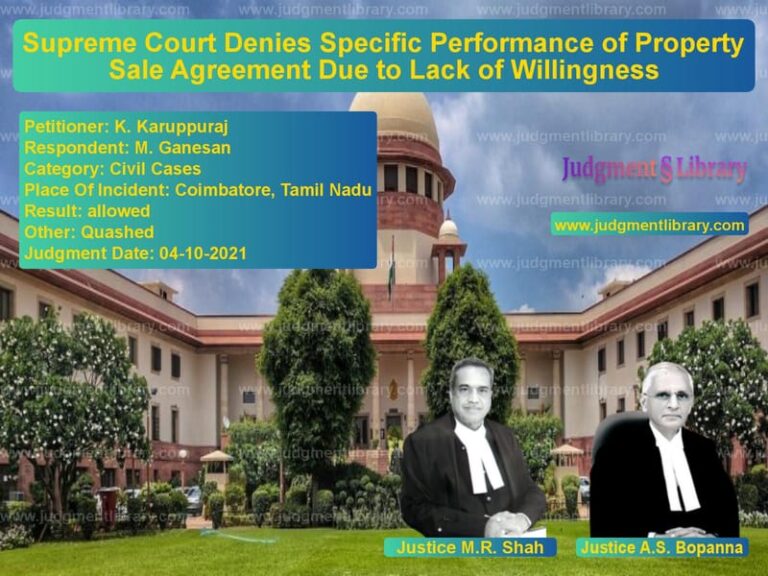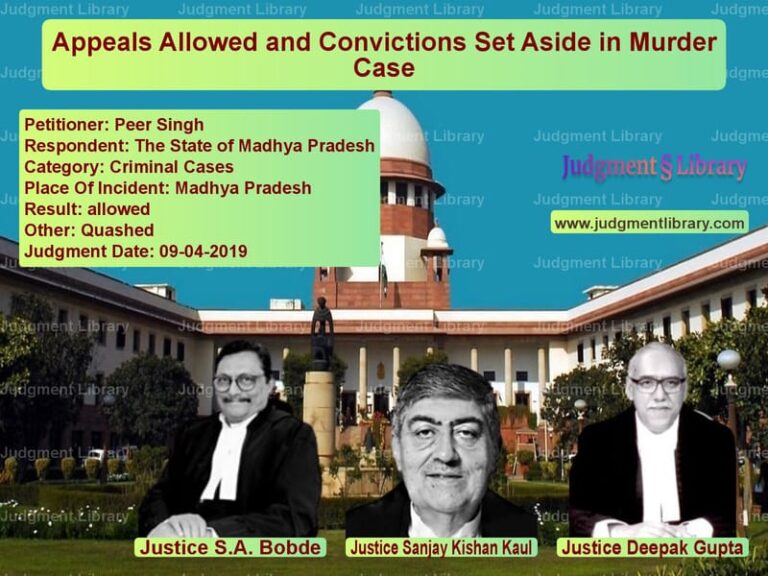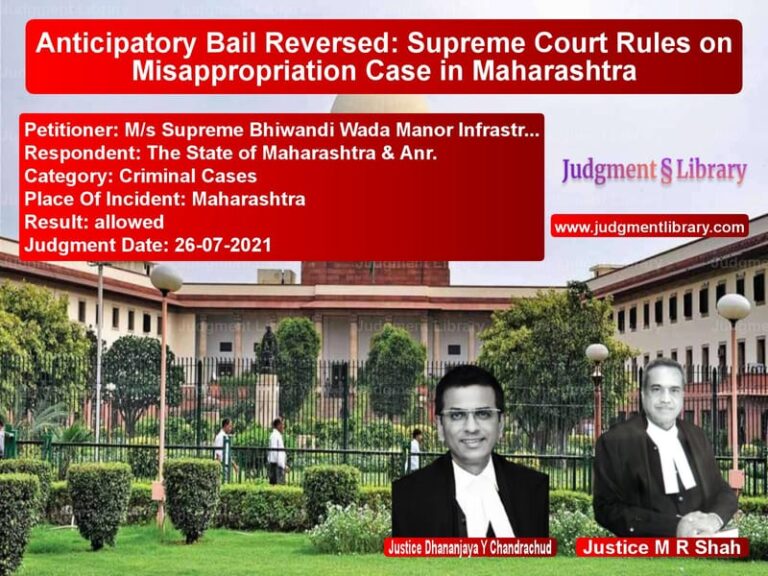Supreme Court Acquits Ram Niwas in Haryana Murder Case Citing Lack of Evidence
The Supreme Court of India, on August 11, 2022, delivered a landmark judgment in the case of Ram Niwas vs. State of Haryana. The case revolved around the murder of Dalip Singh in 2003, where the accused, Ram Niwas, was convicted under Section 302 and Section 201 of the Indian Penal Code (IPC). The Supreme Court overturned the conviction due to lack of conclusive evidence, inconsistencies in witness statements, and failure to establish an unbroken chain of circumstantial evidence.
The ruling highlights the principle that suspicion, however strong, cannot replace proof beyond a reasonable doubt in criminal law. The judgment serves as an important precedent reinforcing the need for reliable evidence in murder convictions.
Background of the Case
The case dates back to March 7, 2003, when the deceased Dalip Singh went to the house of the accused, Ram Niwas, in village Rewli, Haryana, along with his brother Deep Chand (PW-9) and Bhim Singh (PW-10). Their purpose was to discuss the remarriage of Sunita, the sister of Ram Niwas, with Rampal, son of the deceased Dalip Singh.
The prosecution alleged that during the meeting, the accused, Ram Niwas, got into an argument with Dalip Singh after consuming liquor. The next morning, when Deep Chand and Bhim Singh inquired about Dalip Singh, they were told by Ram Niwas that he had gone out. However, they later discovered the partially burnt body of Dalip Singh hidden in a heap of paddy fodder.
Trial Court Conviction
The Trial Court in Sonepat convicted Ram Niwas under:
- Section 302 IPC (Murder): Life imprisonment with a fine of Rs. 5,000, with an additional two years of rigorous imprisonment in case of default.
- Section 201 IPC (Causing disappearance of evidence): Three years of rigorous imprisonment with a fine of Rs. 2,000.
High Court Appeal
Ram Niwas appealed against the conviction before the Punjab and Haryana High Court, which dismissed his plea on March 16, 2009. The High Court upheld the conviction, relying on:
- The testimonies of PW-9 (Deep Chand) and PW-10 (Bhim Singh).
- The alleged extra-judicial confession made by the accused to the prosecution witnesses.
- The forensic evidence of burnt remains found at the crime scene.
Arguments Before the Supreme Court
Appellant’s (Ram Niwas) Arguments
Senior Advocate Rishi Malhotra, representing the accused, argued:
- The identity of the burnt body was not conclusively established as that of Dalip Singh.
- The postmortem report noted that the face of the body was unrecognizable, making identification questionable.
- The testimonies of PW-9 and PW-10 were inconsistent and contained multiple contradictions.
- The alleged extra-judicial confession was unreliable and should not be the sole basis for conviction.
- The accused had been falsely implicated due to longstanding enmity between the families.
Respondent’s (State of Haryana) Arguments
The prosecution, represented by Additional Advocate General Birendra Kumar Choudhary, countered:
- The prosecution witnesses (PW-9 and PW-10) had given consistent testimonies about the events leading up to the murder.
- The accused had made an extra-judicial confession to the witnesses.
- The presence of the burnt body at the accused’s residence was sufficient circumstantial evidence.
- The recovery of ashes and burnt plastic bag supported the prosecution’s case.
Supreme Court’s Observations
1. Unreliable Identification of the Dead Body
The Supreme Court noted that the prosecution failed to conclusively prove that the burnt body belonged to Dalip Singh. The postmortem report indicated:
“The face of the body was unrecognizable, both feet were missing, and the body had deep burns. Given these circumstances, the prosecution had the duty to establish identity beyond a reasonable doubt.”
2. Contradictions in Witness Testimonies
The Court found inconsistencies in the statements of PW-9 and PW-10:
- Despite allegedly discovering the body in the morning, they did not immediately inform the police.
- They left for their village and returned in the evening before filing an FIR, raising doubts about the prosecution’s timeline.
- Although there were multiple houses near the crime scene, no independent witness was examined.
3. Flaws in Extra-Judicial Confession
The Court ruled that the alleged extra-judicial confession was unreliable:
“The extra-judicial confession cannot be the sole basis of conviction unless it is corroborated by independent and cogent evidence.”
4. Lack of Forensic Evidence
The Court observed:
“No DNA test was conducted to establish the identity of the body. The prosecution relied solely on circumstantial evidence, which failed to meet the standard of proof required for conviction.”
Final Judgment
The Supreme Court acquitted Ram Niwas, ruling:
“The prosecution has failed to establish the accused’s guilt beyond a reasonable doubt. The conviction and sentence imposed by the Trial Court and affirmed by the High Court are set aside.”
The Court ordered:
- Acquittal of Ram Niwas due to lack of conclusive evidence.
- Immediate release of the accused.
- Dismissal of all pending applications.
Impact of the Judgment
The ruling has far-reaching implications:
- Reinforces the principle of “proof beyond a reasonable doubt” in criminal law.
- Highlights the importance of forensic evidence in cases involving disputed identities.
- Sets a precedent for extra-judicial confessions, cautioning courts against relying on them without corroborative evidence.
Conclusion
The Supreme Court’s ruling in Ram Niwas vs. State of Haryana underscores the need for conclusive evidence in murder trials. By acquitting the accused, the Court reaffirmed the principle that a conviction cannot be based on mere suspicion or unreliable circumstantial evidence. This judgment serves as a strong reminder that in criminal cases, the prosecution must prove guilt beyond any reasonable doubt.
Petitioner Name: Ram Niwas.Respondent Name: State of Haryana.Judgment By: Justice B.R. Gavai, Justice Pamidighantam Sri Narasimha.Place Of Incident: Rewli, Haryana.Judgment Date: 10-08-2022.
Don’t miss out on the full details! Download the complete judgment in PDF format below and gain valuable insights instantly!
Download Judgment: ram-niwas-vs-state-of-haryana-supreme-court-of-india-judgment-dated-10-08-2022.pdf
Directly Download Judgment: Directly download this Judgment
See all petitions in Murder Cases
See all petitions in Bail and Anticipatory Bail
See all petitions in Custodial Deaths and Police Misconduct
See all petitions in Judgment by B R Gavai
See all petitions in Judgment by P.S. Narasimha
See all petitions in allowed
See all petitions in Quashed
See all petitions in supreme court of India judgments August 2022
See all petitions in 2022 judgments
See all posts in Criminal Cases Category
See all allowed petitions in Criminal Cases Category
See all Dismissed petitions in Criminal Cases Category
See all partially allowed petitions in Criminal Cases Category







